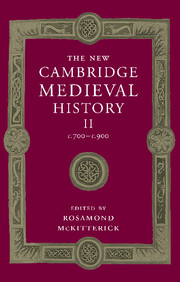Book contents
- Frontmatter
- PART I POLITICAL DEVELOPMENT
- PART II GOVERNMENT AND INSTITUTIONS
- PART III CHURCH AND SOCIETY
- PART IV CULTURE AND INTELLECTUAL DEVELOPMENTS
- 25 Eighth-century foundations
- 26 Language and Communication in Carolingian Europe
- 27 The Carolingian renaissance: education and literary culture
- 28 Theology and the organisation of thought
- 29 Book production in the Carolingian empire and the spread of Caroline minuscule
- 30 Art and architecture
- Conclusion
- Appendix genealogical tables
- List of primary sources
- Bibliography of secondary works arranged by chapter
- Index of manuscripts
- General index
- Frontispiece">
- Plate section
- Map 4 Charlemagne’s Europe and Byzantium, 814
- Map 19 The ecclesiastical provinces of western Europe 700-900
- Map 20 Carolingian schools, scriptoria and literary centres
- Genealogical table X: Wessex
- References
30 - Art and architecture
from PART IV - CULTURE AND INTELLECTUAL DEVELOPMENTS
Published online by Cambridge University Press: 28 March 2008
- Frontmatter
- PART I POLITICAL DEVELOPMENT
- PART II GOVERNMENT AND INSTITUTIONS
- PART III CHURCH AND SOCIETY
- PART IV CULTURE AND INTELLECTUAL DEVELOPMENTS
- 25 Eighth-century foundations
- 26 Language and Communication in Carolingian Europe
- 27 The Carolingian renaissance: education and literary culture
- 28 Theology and the organisation of thought
- 29 Book production in the Carolingian empire and the spread of Caroline minuscule
- 30 Art and architecture
- Conclusion
- Appendix genealogical tables
- List of primary sources
- Bibliography of secondary works arranged by chapter
- Index of manuscripts
- General index
- Frontispiece">
- Plate section
- Map 4 Charlemagne’s Europe and Byzantium, 814
- Map 19 The ecclesiastical provinces of western Europe 700-900
- Map 20 Carolingian schools, scriptoria and literary centres
- Genealogical table X: Wessex
- References
Summary
introduction
the eighth and ninth centuries were a formative period for medieval art. By the end of the ninth century fundamental attitudes to art had been established in the Latin, Greek and Islamic worlds, and the essential architectural forms that would characterise their religious structures for centuries to come had been defined. Moreover, the role of pictorial arts in religious practice had been actively contested, debated, and eventually largely established. Western Christendom adopted a position between the aniconism of Islam and the intense veneration of sacred icons in Byzantium, emphasising the role of art to embellish holy places and objects and to communicate Christian ideas and Christian history.
The historical significance of medieval art and the conscious intentions of medieval artists have long been defined primarily in referential rather than contextual terms, emphasising copying rather than creation as the fundamental character of early medieval art. Certainly many links between the art of the early middle ages and that of early Christian antiquity have been discovered and explicated in terms of both form and content, style and iconography. Indeed the understanding of an artistic creation such as the Douce ivory book cover (Plate 1) requires the identification of the pictorial models upon which some of its images closely rely. Even when early sources were clearly followed and evoked, however, their meaning was often altered in original ways, in this example so as to bear upon contemporary Carolingian political and theological controversies. Engagement with the present far outweighed interest in the past, and recent studies have sought to understand how early medieval western art contributed to the central mission defined in contemporary documents, leading the Christian community towards salvation.
Keywords
- Type
- Chapter
- Information
- The New Cambridge Medieval History , pp. 809 - 844Publisher: Cambridge University PressPrint publication year: 1995

